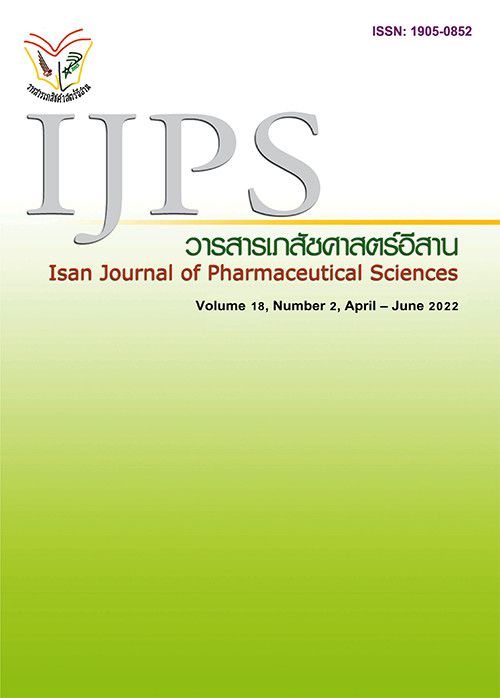Development of Nanoemulsion Containing Yang-Na Oleoresin for Topical Delivery
Main Article Content
Abstract
Introduction: Nanoemulsions are one of drug delivery systems, which can enhance transdermal permeation, especially via stratum corneum, and improve the stability of active compounds. This study aimed to formulate and characterize an oil in water (o/w) nanoemulsions containing Yang-na oleoresin using high enerny method, as well as evaluate physical stability of the formulations. Materials and methods: Pseudo-ternary phase diagrams were constructed to identify the nanoemulsion regions. The formulations contains 2% (w/w) of Yang-na oleoresin. The size, size distribution and zeta poetnetial of the nanoemulsions were determined using particle size analyzer and morphological shape of the preparations were visualized by scanning electron microscope (SEM). The antioxidant activity and total phenolic compounds of oleoresin and the formulations were investigated by the DPPH assay and Folin Ciocalteau method, respectively. Results: The optimized nanoemulsions consists of isopropryl myristate as oil phase, tween® 60 as surfactant, ethanol as co-surfactant (in a mixing ratio of 2:1) and water. The formulations in the presence of Yang-na oleoresin were clear with a spherical in shape and narrow distribution. The size ranged between 29-162 nm and zeta potential were between -9 to -24 mV. The pH values of the formulations were close to the physiological pH of the skin. Obtained results showed that the antioxidant activity of 2% Yang-na oleoresin was equivalent to 0.069 mM Trolox Equivalent (mM TE) from DPPH assay, and total phenolic compounds was 0.034 mg GAE/ml. Encapsulation efficiency (%) of the nanoemulsions was 77.57% - 90.26%. In addition, after 6 cycles of heating-cooling cycle stability testing, the nanoemulsions were clear and no phase separation was observed. Conclusions: Nanoemulsions containing Yang-na oleoresin revealed suitable stability and potential antioxidant properties. A strategy to combine nanoemulsions and Yang-na oleoresin described in the study would therefore be a valuable approach to develop a topical skin cosmetic in an industrial scale.
Article Details

This work is licensed under a Creative Commons Attribution-NonCommercial-NoDerivatives 4.0 International License.
In the case that some parts are used by others The author must Confirm that obtaining permission to use some of the original authors. And must attach evidence That the permission has been included
References
Aslam MS, Ahmad MS, Mamat AS. A Phytochemical, ethnomedicinal and pharmacological review of genus Dipterocarpus. Int J Pharm Pharm Sci 2015; 7(4), 27-38.
Balasundram N, Sundram L, Samman S. Phenolic compounds in plants and agri-industrial by-products: Antioxidant activity, occurrence, and potential uses. Food Chem 2006; 99(1), 191-203.
Chen L, Hu J, Wang S. The role of antioxidants in photoprotection: A critical review. J Am Acad Dermatolo 2012; 67, 1013-1024.
Chime SA, Kenechukwu FC, Attama AA. Nanoemulsions: advances in formulation, characterization, and applications in drug delivery. Application of Nanotechnology in Drug Delivery 2014, Retrieved March 2, 2021. from https://dx.doi.org/10.5772/15371
Clares B, Calpena AC, Parra A, Abrego G, Alvarado H, Fangueiro JF, et al. EB. Nanoemulsions (NEs), liposomes (LPs) and solid lipid nanoparticles (SLNs) for retinyl palmitate: Effect on skin permeation. Int J Pharm 2014 473(1), 591–598.
Donsì F, Sessa M, Mediouni H, Mgaidi A, Ferrar G. Encapsulation of bioactive compounds in nanoemulsion- based delivery systems. Procedia Food Sci 2001; 1: 1666–1671.
Escobar-Chávez J, Díaz R, Rodriguez-Cruz IM, Dominguez-Delgado, Sampere-Morales, Angeles-Anugiano, et al. Nanocarriers for transdermal drug delivery. Res Rep Transdermal Drug Deliv 2012; 1, 3–17.
Fanun M. Colloid in drug delivery, Surfactant Science Series Vol., 2010, Boca Raton, FL: Taylor & Francis/CRC Press.
Kammeyer A, Luiten RM. Oxidation events and skin aging. Ageing Res Rev 2015; 21, 16-29.
Lathsamee T, Khunkitti W, Sakloetsakun D. Preparation and characterization of polymeric nanoparticles loaded with Yang-na oleoresin (Dipterocarpus alatus Roxb. Ex G. Don) [master’s thesis]. Graduate school: Khon Kaen University, 2018.
Maleelai W. Study of physical properties and development of skin lightening product from Raphanus sativus extract [master’s thesis]. Graduate school: Khon Kaen University; 2019.
Mostafa DM, Kassem AA, Asfour MH, Okbi SYA, Mohamed DA, Hamed TES. Transdermal cumin essential oil nanoemulsions with potent antioxidant and hepatoprotective activities: In-vitro and in-vivo evaluation. J Mol Liq 2015; 212, 6-15
Nipaporn N, Somporn K, Nattida, W. The study of antioxidant capacity of ethanolic extracts from Yang-na tree (Dipterocarpus alatus Roxb. Ex G. Don). Proceeding of the 2nd NEU National and International Research Conference 2014 May 24; Khon Kean, Thailand.
Ostolska I, Wiśniewska M. Application of the zeta potential measurements to explanation of colloidal Cr2O3 stability mechanism in the presence of the ionic polyamino acid. Colloid Polym Sci 2014; 292(10): 2453-2464.
Petcharoen K., Sirivat A. Synthesis and characterization of magnetite nanoparticles via the chemical co-precipitation method. Mat Sci Eng B 2012, 177: 421-427.
Ramrit T, Yingngam B, Rungseevijitprapa W. Development of Triphala niosomes. IJPS 2014; 9(Supplement), 22-26.
Salopek B, Krasić D, Filipowić S. Measurement and application of zeta-potential. Rudarsko-Geolosko-Naftni Zbornik 1992; 4:147–151.
Sutin S. Vitamins and free Radicals [Master thesis]. Division of Physical Science, Faculty of Science and Technology: Huachiew Chalermprakiet University, Samutprakarn; 2016.
Silva HD, Miguel A, Cerqueira, Souza BWS, Ribeiro C, Maria C, et al. Nanoemulsions of ß-carotene using a high-energy emulsification-evaporation technique. J Food Eng 2011; 102(2), 130-135.
Tadros TF. Formulation of Dispense Systems: Science and Technology 2014. Weinheim, Germany: Wiley-VCH.
Tuoriniemi J, Johnson A-C J, Holmberg JP, Gustafsson S, Gallego-Urrea JA, Olsson E, et al. Intermethod comparison of the particle size distributions of colloidal silica nanoparticles. Sci Technol Adv Mater 2014; 15(3), 1-11.
Ud-Daula AS, Demirci F, Salim KA, Demirci B, Lim LB, Baser KHC, et al. Chemical composition, antioxidant and antimicrobial activities of essential oils from leaves, aerial stems, basal stems, and rhizomes of Elingera fimbriobracteata (K. Schum). RM SM. Ind Crops and Prod 2016; 84, 189-198.


